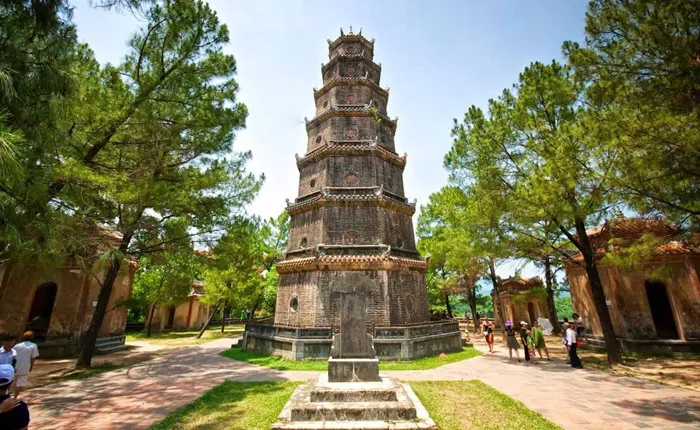Thien Mu Pagoda is a famous Buddhist temple with a long history and rich culture. It is a place where many believers come to pray, seek peace, and learn about Buddhism. The temple combines natural beauty with traditional temple architecture and deep spiritual meaning. This article will explore the legends of Thien Mu Pagoda, its location, and provide a detailed visiting guide for tourists and pilgrims.
Legends of Thien Mu Pagoda
The Origin Story
The story of Thien Mu Pagoda dates back hundreds of years. According to legend, the temple was founded after a monk had a vision of the “Heavenly Eyes” (Tianmu in Chinese) while meditating in the mountains. These eyes symbolized wisdom and compassion, two core values in Buddhism. Inspired by this vision, the monk built the temple to spread Buddhist teachings and help people find inner peace.
The Heavenly Eyes
The temple is named after these heavenly eyes, which are said to watch over all beings. Visitors often see two stone carvings of eyes at the temple entrance. These eyes remind everyone to open their minds and hearts to the teachings of Buddha. Many believe that the eyes bring protection and guidance in daily life.
Stories of Miracles
There are many stories of miracles linked to Thien Mu Pagoda. One famous story tells of a local farmer who was saved from disaster after praying at the temple. His faith in the temple’s power strengthened the community’s belief and drew many more visitors. These stories highlight the temple’s spiritual importance beyond just being a place of worship.
Location of Thien Mu Pagoda
Geographical Setting
Thien Mu Pagoda is located in a beautiful mountainous area, surrounded by lush forests and fresh air. The temple’s location was chosen for its natural tranquility, which supports meditation and reflection. The mountains and streams nearby add to the peaceful atmosphere that visitors seek.
How to Get There
Reaching Thien Mu Pagoda is convenient by both public transport and private car. Visitors can take a bus or taxi from the nearest city or train station. The roads leading up to the temple are well-maintained but may require some walking uphill. It is recommended to wear comfortable shoes and bring water during the visit.
Nearby Attractions
The temple is close to several other cultural and natural sites. Visitors can explore hiking trails, scenic spots, and smaller temples in the area. Combining a trip to Thien Mu Pagoda with these nearby attractions offers a full day of sightseeing and spiritual experience.
Architecture of Thien Mu Pagoda
Overview of Buddhist Architecture
The design of Tianmu Temple reflects traditional buddhist architecture. It uses wooden structures, tiled roofs, and carved decorations. These elements are not only beautiful but also represent Buddhist teachings and values.
Main Hall and Statues
The main hall houses a large statue of the Buddha, surrounded by statues of bodhisattvas. The statues are carved with great detail and represent different aspects of Buddhist compassion and wisdom. The hall is used for prayers, chanting, and meditation.
Other Buildings
The temple complex includes several smaller halls, meditation rooms, and living quarters for monks. Each building has its own purpose and design but follows the harmony and simplicity common in Buddhist temples. The layout encourages visitors to move slowly and reflect deeply as they walk through the space.
Visiting Guide for Thien Mu Pagoda
Best Time to Visit
The best time to visit Thien Mu Pagoda is during spring and autumn when the weather is mild, and the natural scenery is at its best. Festivals and special Buddhist ceremonies also take place at certain times, offering visitors a chance to see traditional rituals.
What to Expect During Your Visit
Visitors should be prepared for a calm and respectful environment. Photography is usually allowed, but it is best to ask permission before taking pictures inside halls. Many visitors come to meditate, light incense, or participate in chanting sessions led by the monks.
Guided Tours and Activities
Some temples offer guided tours that explain the history and meaning behind different parts of the temple. Participating in a tour can deepen your understanding of Buddhist culture. There are also meditation classes and Buddhist lectures available for those interested in learning more.
Etiquette and Tips
- Dress modestly and comfortably.
- Remove your shoes before entering halls.
- Speak softly and avoid loud noises.
- Follow the monks’ instructions during ceremonies.
- Respect the sacred objects and statues.
Conclusion
Thien Mu Pagoda is not only a place of worship but also a cultural and historical treasure. Its legends inspire faith, its location offers natural beauty, and its architecture reflects deep Buddhist values. Whether you are a believer or a traveler, visiting Thien Mu Pagoda can be a meaningful and peaceful experience.

